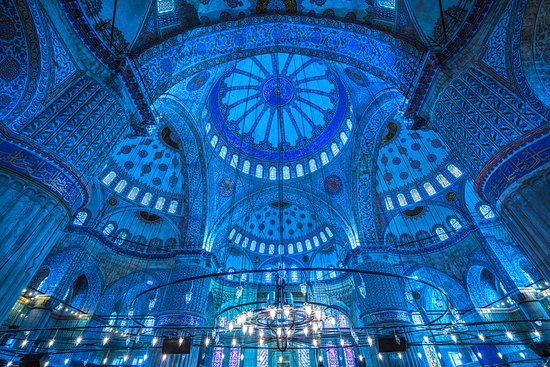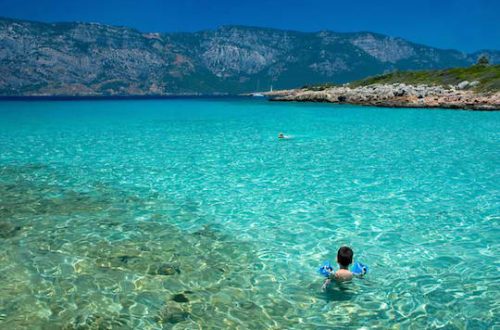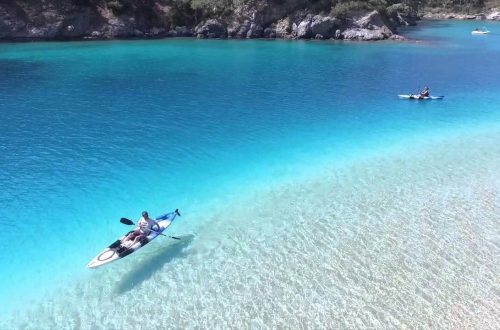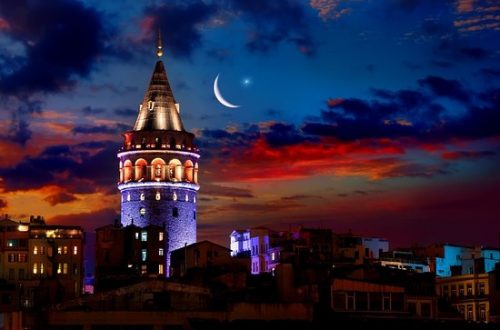
The Blue Mosque
The Blue Mosque (Sultan-Ahmet Camii) in Istanbul
The Blue Mosque in Istanbul is the masterpiece of Ottoman architecture and an international magnet for millions of tourists.
Unfortunately, little information exists about the visit and architecture of the mosque.
I want to change all that with this blog post!
I will briefly answer the most important questions for you:
These are: Clothing for men and women, entrance fee to the mosque and its opening times.
We will cover
- 1. Entrance to the mosque (opening times, clothing, admission)
- 2. The extraordinary architecture of the Blue Mosque
1. Entry to the Blue Mosque, clothing and opening times:
The mesmerizing exterior of the Blue Mosque is hard to resist.
This is due to its harmonious shape and the six minarets. They shape Istanbul’s old town district of Sultanahmet.
You can see the minarets from the T1 tram station Sultanahmet. The station is right on the edge of the square, between Hagia Sophia and the Blue Mosque.
In the days of ancient Rome, a part of the hippodrome of Constantinople stood on this very spot.
Today, you have a spectacular view of the 1,500 year old Hagia Sophia and the Blue Mosque from the square.
The Main (and visitor) Entrance to the Mosque
The Blue Mosque is surrounded by an enclosing wall. There are gates on all sides. Through them, you can get to the outer courtyard of the mosque.
This courtyard contains a park with ancillary buildings: For example, here is where you will find the mausoleum of Sultan Ahmet I. He was the one who commissioned the construction of the Blue Mosque.
The main entrance is in the courtyard of the mosque. It can only be used by believers.
The side entrance in the outer courtyard is open to tourists: It is easy to find. You can’t miss it.
Note:
Ignore “vendors” who promise you a chance to skip the line.
They want to sell you something and most of the time they only take you to a store.
You will end up spending more time at the entrance for visitors than in the mosque.
There is no way to shorten the waiting time. It is just something you’ll have to come to terms with.
But it does pays off!
The only alternative to the queues at the Mosque is the Suleymaniye Mosque. It is just as beautiful, but less well known.
Free Entry to the Blue Mosque
Visiting the Blue Mosque is free. It is free and it will remain so.
The mosque is still used by believers. They have their rules – so abide by them!
I will briefly describe them:
Important: You must follow the dress code when you enter the interior of the Blue Mosque!
Men and women must cover their shoulders.
Shoes must be removed: socks can stay on …
… Free plastic bags for shoes will be distributed at the visitor entrance.
Men are not allowed to wear shorts. Women should wear a skirt.
In addition, as a woman, you will have to place a towel over your hair.
Don’t worry: if you don’t have a scarf with you, if you are a man and you are wearing shorts or if you are a woman and not wearing a skirt …
… there are free skirts and shawls to borrow at the entrance. They are clean and freshly washed.
Important: You can only visit the Blue Mosque outside of prayer times!
The opening time depend on prayer times! There is no fixed schedule; it all
depends on the position of the sun. That’s why they are different depending on the season.
Current times of the prayers for dawn, sunrise, noon and evening can be found here.
Alternatively, you can listen for the speakers on top of the minarets.
You can hear the muezzin calling from all the corners of Istanbul? Good. That means that
the Blue Mosque is closed for 30 minutes.
Mosques are also closed to tourists at noon on Friday: Friday prayer is in Islam is similar to what Sunday prayer is in Christianity.
2. The extraordinary architecture of the Sultan Ahmet Camii
The Blue Mosque is an extraordinary historical place.
You can already get an impression of its superior craftsmanship from the outside.
The six minarets of the Blue Mosque are also distinctive. They are one of the mosque’s unique characteristics.
At the time of its completion (1616) there was only one mosque with so many minarets – and that was the Prophets Mosque in Mecca.
In regard to the six minarets of the Blue Mosque …
… Sultan Ahmet I paid for an extra (7th) minaret for the mosque in Mecca.
There is another story about the minarets of the Blue Mosque:
Sultan Ahmet I commissioned the architect Mehmet Aga to build the minarets from gold.
Golden minarets would have significantly exceeded Aga’s budget.
It is difficult to say “No” to the Sultan: This is why architect Aga is said to have intentionally understood the word “altın” (gold) as “altı” (six).
Is the story about the golden minarets true?
That’s a good question – It’s a tale told by the tour guides in Istanbul.
In any case, the name Sultan Ahmet and his influence still persist: The district around the Blue Mosque bears the name – Sultanahmet.
With his construction of the mosque, he made his name immortal.
The interior of the mosque and the blue Iznik tiles
The Sultanahmet Camii is called “The Blue Mosque” or “Blue Mosque” only outside of Turkey.
The reason for its nick-name is the 20,000 glowing blue Iznik tiles inside.
They are attached to the walls and ceilings of the mosque as decorations.
This is due to the art of Islam:
In mosques, there are no paintings like in a church. People are not represented at all.
Instead, the domes, pillars, and walls are decorated with calligraphy, gold leaf, and patterns.
The calligraphies consist of suras from the Koran – which are written as artistically as possible.
You can learn more about the art of Islam at the Museum of Turkish and Islamic Art. It’s right across from the Blue Mosque. You may enter one part of the museum for free.
The mosque’s internal ornamentation with its tiles and calligraphy fit perfectly symmetrically with the architecture of the mosque.
This symmetry, together with its architecture, makes the mosque look exceptionally interesting and pleasing to the eye.
This is most noticeable on the 43 meter high dome.
This creates an incredibly harmonious feeling of space.
In contrast to Hagia Sophia, the dome looks much more delicate.
At Hagia Sophia, its meter-thick walls are quite noticeable. This is due to the accumulated experience of the architects over the centuries.
Layout of the mosque interior
The Blue Mosque is oriented towards Mecca.
Its central element is the mihrab. This is the prayer niche on the front, for the Imam.
The men’s area of the Blue Mosque is separated from the visitor area with a wooden fence.
What is the fence for?
It protects the believer from being disturbed during prayer. For this reason, flash photography is not allowed.
In addition to its huge dome, the red carpet in the mosque is striking.
In keeping with the name “Blue Mosque”, it is decorated with blue floral patterns.
The gorgeous carpet is one of the reasons why you must remove your shoes at the entrance.
Another reason is the Islamic law of purity. For example, before going to a mosque, believers must wash their feet and hands three times.
Behind the visitor area, you will see the niches for the women, who have a separate area in each mosque.
The women’s area is also separated by wooden fences in the Blue Mosque.
There are niches on the left and right of the entrance. In front of them is a wooden fence and shelves as a screen for privacy.
Ornaments are cut into the fence. The women can see through the patterns.
The compartments are also carpeted. The women pray just like the men do, each in his or her area.
The architecture of the Blue Mosque
Construction of the Blue Mosque is based on the Hagia Sophia.
It is the model for all the mosques in Istanbul – although it is 1,000 years older than the Blue Mosque.
For this reason, the layout of the Blue Mosque is somewhat similar to that of a church with a three nave construction.
There is a central dome, along with a left side and right side.
The construction technology of the Blue Mosque is an improvement, in comparison to Hagia Sophia.
The weight of the domes, for example, is distributed across fewer pillars, which has created more space for windows.
The few load-bearing elements make the interior appear larger and freer.
This is particularly noticeable under the 43 meter high dome. It is only supported by four massive pillars.




